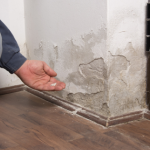What To Do if Your Home is Damaged by a Flood
If your home has been damaged by a flood it is important to take action within the first 24 hours. Doing so will make sure to keep your family, others, and home safe and will give you the best possible outcome when it comes to your insurance company.
Here’s what you need to do during the first 24 hours of your home flooding:
Safety and Avoiding Injury
Before anything else, it is important that you remain safe. Safety should be your number one concern and should not be taken lightly. Before entering, look for signs of visible structural damage (cracked foundation, walls, or ceilings, warped floors or ceilings, etc.). Do not enter your home until the water and electricity are turned off. Whether the power working or not, go to your fuse box and turn everything off. You don’t know when it could turn on again. If you suspect any sort of damage, call your utility companies (water, sewer, electric, and gas) right away.
Inform Your Insurance Company
Inform your insurance company of a flood in your home as soon as possible. Keep their phone number, your policy number, and other information in your phone or in an emergency-ready bag. You will need to let them know the current state of your home and any repairs you need to handle right away. They may require an adjuster to assess your home, so heed any instructions they may offer prior to making repairs.
Take Photos of the Damage
Before you start removing water or making any sort of repairs, you should take pictures to fully document the damage. Insurance companies are likely to require photographic evidence. If you start repairing the damages before you take pictures, you might lower the amount of coverage your insurance company is willing to pay. Once you’ve taken your initial photos and you’ve received the “okay” from your insurance company to move forward with repairs, take photos and document every stage of repairs as they take place.
Keep Yourself Healthy
Flooded homes are often contaminated with chemicals and/or sewage. It is important that you take proper precautions and wear waterproof boots, gloves, wading pants, masks, etc. Any food that has been contaminated by flood waters should be thrown out and water should be boiled until the professionals have told you your water is safe to drink or bathe in.
Remove Water
After you’ve received the go-ahead from your insurance company, you can begin to remove water. If you choose to do this yourself, you can purchase a sump pump and a wet vac from your local hardware store. Make sure you are careful! You can easily injure yourself carrying heavy loads of water.
Mold Control
Mold can quickly develop — we’re talking within 24-48 hours! As soon as you can (after the go-ahead from your insurer), remove any and all wet contents. This includes carpet, rugs, bedding, furniture, drywall, baseboards, toys, etc. As you remove these items, document them with photos for your insurance company. Please note that it is best to leave this job to a professional flood restoration company as it can be quite dangerous. The cleaning solutions alone can be very toxic.
For more information or for help settling your insurance claim, reach out to Hudson Douglas Public Adjusters today for a free claim review.




